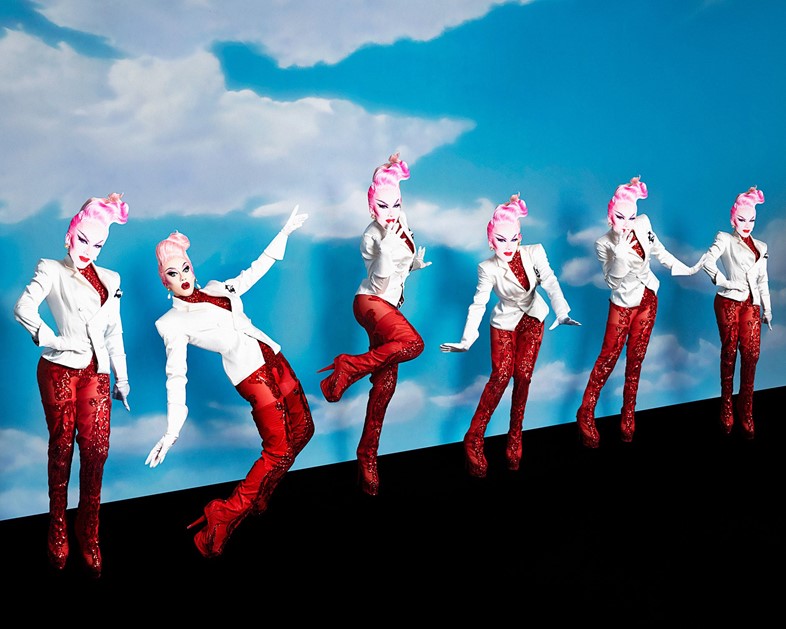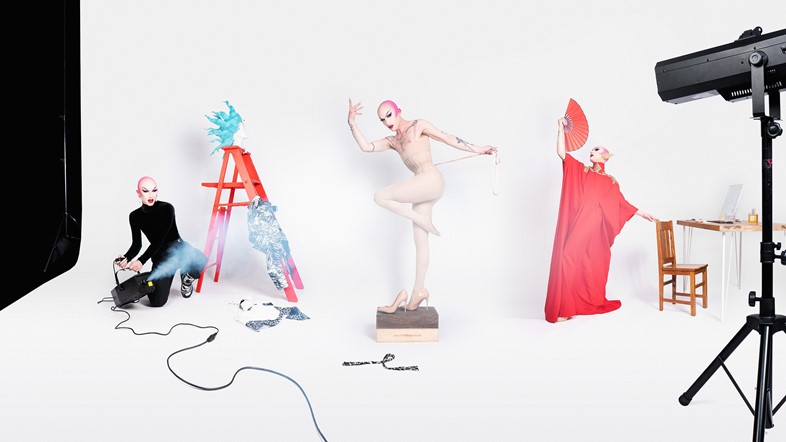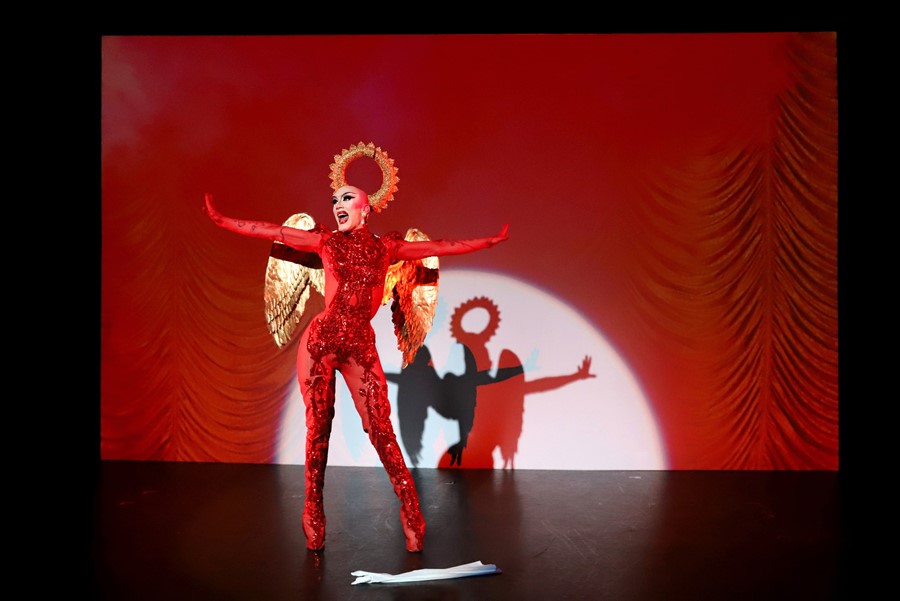As Sasha Velour’s Smoke & Mirrors tour arrives in the UK and Europe, the drag personality sits down with Amanda Feinman to discuss the self-produced show and the multifaceted Velourian universe
There are many Sasha Velours onstage during Smoke & Mirrors. Quite literally: through projection mapping, her recognisable practice of blending live performance with pre-recorded video, Velour sometimes serves as her own back-up dancer, her own magician’s assistant, her own creative collaborator, her own worst enemy. The season nine winner of RuPaul’s Drag Race will bring her one-queen stage show – comprised of 13 fully-realised lip-syncs, personal storytelling, and a bit of magic – to the UK this March. And with it comes all the many shades of herself: the pre-fame hesitator, the offstage intellectual, and the heightened, otherworldly incarnation we know from our television screens, too. They’re kind of a package deal.
Part of Velour’s broad artistic project is to explore this theme of abundance within the self, and to assert that it isn’t always easy, or important, to parse out what’s “true”. She dabbles in “pulling back the curtain” on the art of drag, and in winking at theatrical disaster – songs that restart, projections that glitch – all while maintaining control (“it’s about de-mystifying and re-mystifying,” she tells me, and for a moment, I’m not sure who is conducting the interview). Especially with Nightgowns, the beloved drag revue she regularly directs and hosts in her home borough of Brooklyn, she blends glittering theatrics with a deep, researched sense of queer history and community – none of which is incongruous, even if it seems to be. The Velourian universe is multifaceted, dynamic. And, perhaps above all, it’s super intentional. When she speaks about drag from her couch, she mentions “polish” and “respect” in the same breath; for her, the drag to be most proud of is the drag that’s been deeply thought about, worked over, lived in. A dream dreamed all the way through.
I sat down with Velour ahead of the UK leg of her self-produced Smoke & Mirrors tour: we discussed some of the ideas behind the show, and the upcoming Nightgowns docu-series (it will premiere this spring, on short-form streaming platform Quibi). Our conversation is condensed below.

Amanda Feinman: How do you describe Smoke & Mirrors, for those who haven’t seen it yet?
Sasha Velour: It’s very theatrical – circus-y, almost – but I try to stay very true to drag, in the sense that it’s really personal. Honest, through over-the-top fantasy. There’s bits of humour, a passionate love of the reveal, a non-binary approach to life – not just in terms of fashion, but a way of thinking about life and meaning. When it comes to the binaries of life – good and evil, masculine and feminine, reality and fantasy – I’ve learned the truth rarely matches up with such binary extremes; it’s much more likely to be found somewhere in between. A couple of performances are about competing creations of yourself. Versions of yourself designed for others, or for specific situations, and your own vision of yourself. With lip-syncing to a voice that’s not quite mine, and performing with a world of visuals [that] are not quite real ... there’s always this sliding grasp on what is real, with a love of things that are not.
AF: Right. This dichotomy of reality and fantasy.
SV: When it comes to that idea, like a Modernist, ‘we create false selves for the world, and you have to be in touch with the true self’ – that’s not a very drag approach. Sometimes the false selves you create are more authentic than the self that’s been reinforced through narratives the whole time.
AF: I know that your interest in disaster, theatrical and otherwise, partially sparked Smoke & Mirrors. Why does disaster interest you?
SV: Well, I love dramatics! I think drag is a place to find the beauty of really heightened emotions, sometimes not positive ones. Power, from being an emotional person, is something that drag has always given me. And then there’s the camp quality, too, of like ... ambition meeting failure? [Laughs] People who struggle with their gender deal with that in very painful ways sometimes, and I think that’s why it’s such a theme throughout drag. We have to be able to laugh at that experience, so it doesn’t, like, destroy us.
AF: It’s interesting that you say that, because for some people, drag can be very interested in like, sheen, flawlessness…
SV: Yes. Perfection.
AF: Yes. And that contrast, plus what I know of you, makes me curious about your own relationship to perfection.
SV: I’ve always been a believer in polish, versus perfection. We’d talk about that at Drag Race – Trinity Taylor said that even though I don’t have a conventional sense of femininity for the pageant world, my sense of polish would fit right in there. And I think that’s important. Really fine-tuning an idea until it’s clear, because unclear is not better than practised. But yes, [perfection] is still a stumbling block for me. I’m always dramatising my struggle with it. In a show that builds in some purposeful accidents, there’s space for real accidents to seem like they are on purpose – a perfectionist’s best situation!

AF: Next on the horizon is the filmed, streaming version of Nightgowns on Quibi. I want to ask first why that revue remains such an important artistic commitment for you, after years of doing it.
SV: When I think about drag family – my home that I built in the world of drag – I think about Nightgowns specifically. Everything that I learned about the culture and the art of drag came from bringing the most talented performers in Brooklyn – and now, an even wider pool – into this Nightgowns family. I love Drag Race, but Nightgowns stood as another idea, another way to get a bunch of different drag artists together, and celebrate them. Not a competition, not this idea of cis gay guys dressing up as women, but all about the artistry, the fantasy, the theatricality.
AF: It is so theatrical! So many different energies, coming from different people... I imagine it was challenging to translate those live performances to a TV format.
SV: That was the scariest part! A single cell phone take – which is how we’re used to seeing [filmed] lip-syncs, for the most part – never captures what it feels like to watch the artist, live, in the room. So I asked one of the most talented music video directors in the world to see if she could figure out how to capture drag! Because Sophie [Muller]’s music videos already lean towards theatrical choices over naturalistic ones, I thought it would be a really good fit. For each number, we thought about the sound of the music, the style of the artist, and then decided what camera fittings could make sense ... a handheld camera on the stage, moving with a performer, or very static shots. Still images, illustrations.
AF: Translating Nightgowns to a streaming platform will also allow many people to see it who can’t physically be in New York. What is the importance of sharing Nightgowns so widely – what will it contribute to the larger drag landscape?
SV: There’s a lot of drag on TV, and most of it – most of the docu-series, most of the coverage – surrounds people who have appeared on RuPaul’s Drag Race. And obviously, that is an element of this show. Drag Race is still one of the only ways to make a name for yourself as a drag artist in a big way. But [in the Quibi series], we shift focus right away, from me to all these other performers. You’ll see that this isn’t a phenomenon that’s limited to one production company, to one gender, or one style. I think we can express how much is out there that’s going unappreciated. Trans drag artists, drag kings, women doing femme drag ... women doing drag really well.
AF: I want to ask, finally, about your relationship to making solo drag art, versus collaborative projects. Why are both important to you? As an artist, as a spokesperson, as a human?
SV: They are both important! It was enjoyable to get to work on something just for myself, to hone some skills in the privacy of my own... disasters. [Laughs.] With groups, I am not just a performer, but also a producer, a director, a host. I have to focus less and less on my own art. Probably the best part of Smoke & Mirrors has been getting to really put effort and focus into performance itself. But then, I don’t feel nearly as challenged working solo as I do with other people! Other people surprise you, and push you in new ways. You can see the ways [the Nightgowns cast has] affected each other’s drag, and grown together. The way we’re thinking about our art, and the meaning of drag... gets really aligned.
AF: Would you share what that Nightgowns meaning of drag is?
SV: Drag is freedom, when it comes to gender. It can be a heightened version of your day-to-day self, or a complete left turn. We all view it as being very historical and political. But I think the most important thing is that it’s about putting on a great performance. And that requires preparation – we all believe that you have to be serious about what you do, when the spotlight comes on you. Drag is all about stage presence, and artwork, and intention.
Smoke & Mirrors is in the UK from March 2, 2020.
